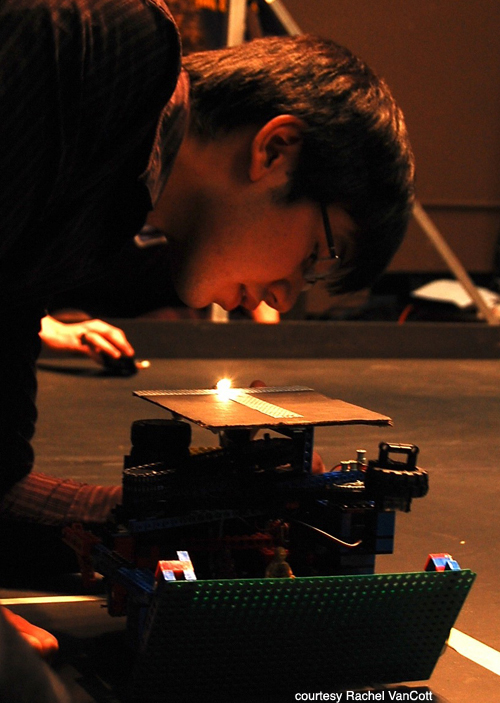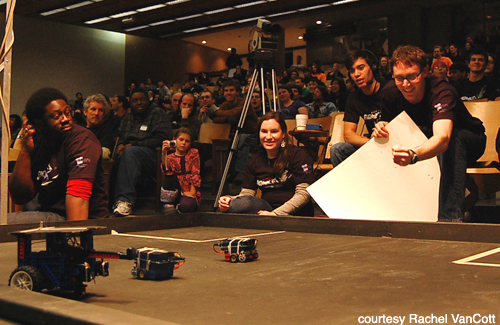 During a break between snow flurries last night, I slogged out to the MIT campus to watch the Autonomous Robot Design Competition. This year, the teams built autonomous "space cats"--Lego robots charged with hunting down and bringing back robot mice that (mostly) wandered the field of play.
During a break between snow flurries last night, I slogged out to the MIT campus to watch the Autonomous Robot Design Competition. This year, the teams built autonomous "space cats"--Lego robots charged with hunting down and bringing back robot mice that (mostly) wandered the field of play. The first few rounds were lackluster. But by the time robot Hulk Smash mistook robot Road Rage for a mouse and raised it high in the air and flipped it, the audience let out a shout.
As the competition wore on, I yelled for robots to look just left, no just left, the mouse is right there, you can do it.
Yeah, get it!
So why did I cheer for an inanimate object? It is not an isolated incident. I've offered emotional support to my computer during a particularly long program install, and tried to talk it down from a freeze up. I've asked a printer (nicely) to reconsider a memory shortage.
It's not a question of cute. I understand why I respond emotionally to
Disney's Wall-e. The little robot has the body language and proportions
of a human toddler, and big, adorable, binocular eyes. I'm
evolutionarily inclined to coddle and care for objects that hit those
triggers.
But these space cats, not to mention my office equipment, didn't even tip the cute scale.

Perhaps it's as simple as the human tendency toward anthropomorphism. The Greeks saw fit to award person-hood to the sun and sea. Aesop's animals spoke and reasoned like humans. Need I mention pet rocks?
As soon as I see an object as animate, I'm just a short step from bonding with it, I admit. In human development, scientists speak of the transitional or comfort object--an object that a child bonds to during early development. The child begins to see the object as an extension of self. In adulthood, it's easy to bond with objects, like computers, that we spend the majority of our waking hours with.
I'm still not sure why I'd bond with an object that I'd just met. But I'm more aware than ever that I do. Do you?
I turned up some interesting stories while I was looking into this. Check out the following:
"Bots on the Ground" from The Washington Post
http://www.washingtonpost.com/wp-dyn/content/article/2007/05/05/AR2007050501009_pf.html
"Toddlers Bond with Robots" from National Geographic
http://news.nationalgeographic.com/news/2007/11/071105-toddlers-kids.html
But these space cats, not to mention my office equipment, didn't even tip the cute scale.
Perhaps it's as simple as the human tendency toward anthropomorphism. The Greeks saw fit to award person-hood to the sun and sea. Aesop's animals spoke and reasoned like humans. Need I mention pet rocks?
As soon as I see an object as animate, I'm just a short step from bonding with it, I admit. In human development, scientists speak of the transitional or comfort object--an object that a child bonds to during early development. The child begins to see the object as an extension of self. In adulthood, it's easy to bond with objects, like computers, that we spend the majority of our waking hours with.
I'm still not sure why I'd bond with an object that I'd just met. But I'm more aware than ever that I do. Do you?
I turned up some interesting stories while I was looking into this. Check out the following:
"Bots on the Ground" from The Washington Post
http://www.washingtonpost.com/wp-dyn/content/article/2007/05/05/AR2007050501009_pf.html
"Toddlers Bond with Robots" from National Geographic
http://news.nationalgeographic.com/news/2007/11/071105-toddlers-kids.html
"I, Rodney Brooks, am a Robot." from IEEE Spectrum
http://spectrum.ieee.org/computing/hardware/i-rodney-brooks-am-a-robot/0
http://spectrum.ieee.org/computing/hardware/i-rodney-brooks-am-a-robot/0



